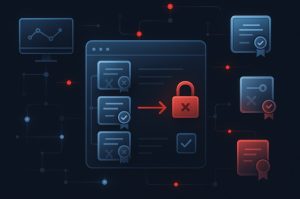
In an age where data breaches, identity theft, and digital fraud are common, how do organisations create an environment of trust in digital communications? As more services, interactions, and transactions shift online, the ability to verify identities, protect sensitive data, and ensure the authenticity of interactions becomes crucial.
This is where Public Key Infrastructure (PKI) plays a fundamental role. PKI forms the backbone of many secure systems and services that power the internet and modern enterprises. But what exactly is PKI in cyber security, how does it work, and why is it indispensable in today’s digital landscape?
What Is Public Key Infrastructure?
Public Key Infrastructure (PKI) is a framework used to secure digital communication by managing encryption keys and digital certificates. It is designed to enable secure data exchange and authenticate the identity of individuals, devices, and systems over both public and private networks. PKI combines various elements like cryptography, identity verification, and digital certificates and to create a system of trust in cyberspace.
The concept of PKI was developed in the 1990s as a solution to manage encryption keys used for secure data transmission. It introduced a system that issued digital certificates to verify the ownership of encryption keys. These certificates function much like digital passports, confirming the legitimacy of the certificate holder in a transaction or data exchange.
Over time, PKI evolved through multiple phases:
- The first wave (1995–2002) saw limited use in eCommerce, where certificates were issued to verify website authenticity.
- The second wave (2003–2010) witnessed enterprise-level adoption as remote work became prevalent. Organisations used PKI for VPN access, device authentication, and secure internal communications.
- The third wave (2011–present) marked the explosion of PKI due to cloud computing, mobile workforce, and the rise of the Internet of Things (IoT), which demands millions of certificates to manage digital identities of devices.
How Does Cryptography Power PKI?
At the core of PKI is cryptography, a discipline concerned with encoding and decoding data to ensure confidentiality and authenticity. Cryptography is what allows PKI to function as a secure, verifiable system for data protection.
There are two main types of encryption used in cryptographic systems:
Symmetric Encryption

Symmetric encryption involves the use of a single key for both encryption and decryption. While this method is computationally fast, it presents a challenge in secure key distribution. If the key is intercepted during exchange, the entire system can be compromised. Historically, this method was used in military communications, such as during World War II.
Asymmetric Encryption

PKI primarily uses asymmetric encryption, which involves a pair of cryptographic keys—a public key and a private key. The public key is used for encryption and can be shared openly, while the private key is kept secret and used for decryption. This method solves the key distribution problem found in symmetric encryption.
A typical PKI scenario would involve a sender encrypting a message using the recipient’s public key. Only the recipient, who holds the matching private key, can decrypt and read the message. Additionally, digital signatures can be applied using the sender’s private key, which the recipient can verify using the sender’s public key to confirm the sender’s identity and message integrity.
What Are the Building Blocks of a Public Key Infrastructure?
PKI is composed of various components that together form a secure and manageable system. Each element plays a crucial role in maintaining trust and operational integrity.
| Component | Description |
| Certificate Authority (CA) | Trusted entity that issues, signs, and manages digital certificates |
| Registration Authority (RA) | Verifies user or device identity before certificate issuance |
| Digital Certificate | Electronic document containing public key, identity information, and expiry |
| Certificate Database | Stores issued certificates and related metadata |
| Certificate Revocation List (CRL) | Lists invalid or revoked certificates |
| Certificate Policy | Outlines PKI’s procedures and standards |
| Central Directory | Stores and indexes public keys |
| Certificate Management System | Manages lifecycle processes like issuance, renewal, and revocation |
How Are Digital Certificates Created and Used in PKI?
A digital certificate, often in the X.509 format, binds a public key to an identity. These certificates are vital for establishing secure, verified connections between users, systems, and devices. They are issued by a Certificate Authority (CA) and serve as a digital proof of identity.
Certificate Creation Process
The process to create a certificate involves several well-defined steps:
- A private and public key pair is generated.
- The user or system creates a Certificate Signing Request (CSR) containing the public key and identity details.
- The CSR is signed by the key owner and sent to a CA.
- The CA validates the identity through its established vetting process.
- The CA signs and issues the certificate using its own private key.
The certificate can then be shared openly, allowing anyone to verify the certificate holder’s identity and trustworthiness, assuming they trust the issuing CA.
Why Are Certificate Authorities (CAs) Critical in a PKI System?
Certificate Authorities are trusted third parties responsible for issuing and managing digital certificates. They determine the vetting process, define certificate policies, and ensure the secure handling of keys.
There are generally two levels of CAs in a hierarchy:
- Root CAs: Self-signed and serve as the trust anchor for the entire hierarchy. These are kept offline and secured with extreme measures, such as physical safes and restricted access.
- Subordinate CAs: Issue certificates on behalf of root CAs. These operate online and are responsible for day-to-day certificate operations.
CA Hierarchies and Trust Chains
A CA hierarchy ensures scalability and flexibility in large networks. Typically, a two-tier hierarchy is recommended: the root CA remains offline, while the subordinate CA handles certificate issuance. The root CA’s security is paramount because if compromised, all certificates under it are affected and cannot be revoked. For this reason, root certificates are long-lived but eventually expire (usually after 15–20 years).
What Is a Certificate Revocation List (CRL) and Why Is It Necessary?
Not all certificates remain valid throughout their lifecycle. If a certificate is compromised or no longer trustworthy, it must be revoked. This is done through a Certificate Revocation List (CRL), which is periodically published by the CA.

The CRL lists certificates that are no longer valid before their expiry. Consumers of certificates such as browsers or applications and they can check these lists to determine whether a certificate should be trusted. This process, while necessary, can slow down authentication. However, it is becoming standard in most secure environments.
How Does PKI Address Identity and Security Challenges?
One of the core challenges in any encrypted communication system is authenticating the owner of the encryption key. PKI resolves this through the binding of public keys to verified identities using digital certificates. This makes it nearly impossible for attackers to impersonate legitimate users without detection.
PKI also protects against man-in-the-middle (MitM) attacks, where a third party intercepts and alters messages. With digital certificates, any modification or interception invalidates the certificate, immediately alerting the user to a potential compromise.
Where Is PKI Used in Real-World Cyber Security Applications?
PKI is embedded in numerous security-critical systems across industries. Common cyber security applications include:
- SSL/TLS certificates for secure websites
- Digital signatures for verifying documents and software
- Email encryption using S/MIME
- Device authentication in VPNs and corporate networks
- IoT security, ensuring firmware authenticity and secure device communication
Industry Use Cases
Automotive Sector: Connected vehicles use PKI to authenticate data transmissions and software updates, protecting against malicious tampering that could impact driver safety.
Medical Devices: Modern pacemakers and surgical robots are now software-driven. PKI ensures secure updates and verifies that only authenticated software can interact with these devices.
How Does PKI Support Cryptographic Best Practices?
In many implementations, symmetric and asymmetric encryption are used together. For instance, a message may be encrypted using a symmetric key (for speed), and that symmetric key is then encrypted using asymmetric encryption for secure transmission.
This hybrid model ensures performance without sacrificing security. However, both systems require careful key management, which is a core function of PKI. Without it, encrypted communication becomes vulnerable to breaches and identity fraud.
Why Is PKI Essential in a Hyperconnected World?
Today’s digital infrastructure includes millions of devices and applications requiring secure identification and encrypted communication. PKI scales to meet this demand, offering a framework that:
- Manages trust at scale
- Validates identities in real-time
- Secures cloud, mobile, and IoT environments
Organisations increasingly rely on managed PKI services and certificate lifecycle management tools to handle the growing complexity. These tools automate issuance, renewal, and revocation, reducing the risk of expired or misconfigured certificates.
Frequently Asked Questions
How does PKI relate to cryptography?
PKI is a framework that uses cryptographic techniques to secure communications and authenticate identities using digital certificates.
What makes digital certificates tamper-proof?
They are digitally signed by trusted Certificate Authorities and include identity details, expiry dates, and validation protocols.
Why are CRLs important?
They help maintain trust by listing compromised or expired certificates, allowing systems to validate certificate status before use.
Is PKI scalable for large organisations?
Yes, with hierarchical CA structures and automated management platforms, PKI can support millions of certificates.
Can PKI prevent phishing attacks?
PKI verifies sender identity through digital certificates, making it harder for attackers to spoof trusted sources.
What happens if a root CA is compromised?
All certificates under it become untrusted. Root CAs are therefore kept offline and secured with rigorous protocols.
Are digital certificates used on mobile devices?
Yes, certificates authenticate mobile users, encrypt emails, and ensure secure VPN access.